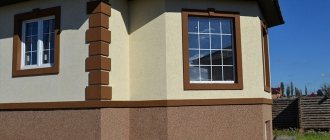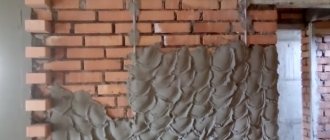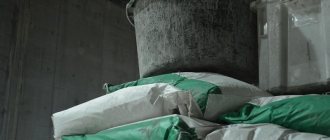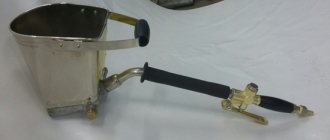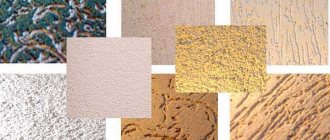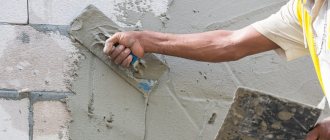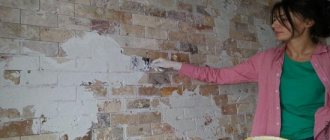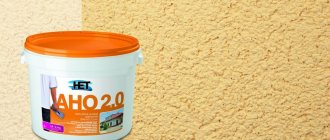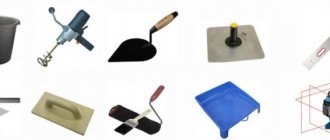When carrying out home repair and improvement activities, one of the most important operations is applying a plaster composition, as well as eliminating uneven surfaces on the walls. The plaster mixture can be purchased at the store or prepared independently from various ingredients. If you prefer the second option, figure out how to prepare a solution for plastering walls. You need to know which components to use, as well as in what ratios to mix them. Let's look at recipe options and cooking technology.
Mortar for plastering walls
What composition of mortar to choose for interior wall plaster
When deciding which solution is preferable to use for plastering surfaces, we will evaluate the characteristics of the ingredients used for bonding, and also consider the types of plaster compositions.
Types of binders and fillers
Used as a binder:
- cement, which provides an increased margin of safety after hardening of the plaster mixture. The setting of the composition, including cement, begins 15–20 minutes after the introduction of water and lasts 10–12 hours. Operational hardness and performance characteristics are acquired after the final completion of the hydration process, which lasts 28 days. For plastering, 400% Portland cement or cement marked M500 is used. Fresh binder must be used. Cement loses its properties and cakes during long-term storage in humid conditions;
- clay, which is a fairly common natural material. Clay-based plaster has been used for centuries to decorate the external walls of wooden buildings, as well as for interior work. Due to the ability of the building material to withstand elevated temperatures, it is used for finishing fireplaces and stoves, and its increased resistance to moisture allows it to reliably protect adobe buildings and wooden buildings from the outside. Due to their low cost and ease of use, clay-based working mixtures are widely used in finishing activities;
- gypsum added to the lime composition as a special additive. It is a powdery substance that can reduce the setting time. If it is necessary to ensure accelerated hardening, then with the help of gypsum the setting time can be reduced to five minutes after diluting the working mixture with water. Final hardening occurs within half an hour. Gypsum powder reduces the settlement of the plaster mass after hardening, and also increases its strength properties;
Mixture for wall plaster - lime. The peculiarity of the material, which is used only after extinguishing, is that it gains hardness upon contact with air. Slaked building material used for plastering, unlike quicklime, is not subject to cracking. Lime is slaked using pits or containers. The technology involves the use of an accelerated or slow extinguishing option over the course of a month. Compositions containing lime are characterized by bactericidal properties, plasticity and reduced price. They have improved adhesion to various surfaces, including wood.
Along with binding components, various fillers are used:
- sand;
- sawdust;
- slags;
- shavings.
The most common is quartz sand, mined from rivers. The technology involves flushing, which removes salts and clay particles. The quality of river sand is superior to similar material mined in quarries. Screened fine, medium and coarse sand is used, the particle size of which ranges from 0.2 to 4 mm.
Types of plastering compositions
Proportions of mortar for plastering walls
When choosing a composition for plastering, it is necessary to take into account a number of factors :
- binder used;
- surface material;
- temperature conditions;
- humidity level.
When choosing the best option for plaster material, pay attention to the following points:
- plasters containing building lime and cement are used for facade finishing, when it is necessary to provide protection from the negative effects of high humidity. If high humidity is expected in the interior, this composition is also used for interior decoration;
- the introduction of clay, slaked lime and gypsum into the plaster composition allows it to be used at high concentrations of moisture in the air. Such mixtures are mainly used for plastering dry heated and unheated rooms located inside the building;
- Cement-gypsum plaster composition, to which clay is added, is used for interior decoration of rooms with normal moisture concentration. It is possible to use these binders when plastering the facade surfaces of buildings operated in dry climates.
Consider these recommendations when selecting a plaster composition.
Use of ready-made leveling compounds
You can mix the plaster mixture yourself or buy it ready-made. The latter is manufactured using technology and supplied dry or liquid. Dry formulations are mixtures of bulk components mixed in certain proportions. They are intended for pre-treatment of walls before further finishing.
The composition of the mixture for plastering walls can be different. It depends on its intended purpose and the quality of surface leveling.
| Dry mixes | Changes (wall irregularities) | Nature of use of the premises |
| Simple | up to 3 mm | Utility rooms, basements |
| Improved | up to 2 mm | Public buildings |
| High quality | up to 1 mm | Living rooms |
Note: there are also specialized dry building mixtures for leveling walls. They provide additional protection for surfaces and have heat-insulating, sound-absorbing, and water-repellent qualities.
Dry leveling mixtures are presented in a large assortment
Liquid plaster for walls is a homogeneous plastic mass. It does not need to be diluted with water, but can be immediately applied to the surface. Such solutions are supplied in plastic/metal buckets. Before applying, just open them and mix with a mixer.
Advice: in order for the liquid plaster composition to better adhere to the surface, the wall must first be coated with a primer.
Ready-made finishing compositions can be leveling and structural
The composition of the solution for plastering walls, presented in finished form, may be different. It depends on the desired effect. There are standard mixtures that provide a smooth surface, and decorative ones that create a certain texture.
Please note: ready-made liquid plaster solutions are more expensive than dry mixtures, but when applied they are consumed less (2-3 times).
A variety of textures created using decorative plasters
How to properly prepare a solution for plaster
Preparation of mortar for plaster
The technology for preparing each type of plaster mortar has its own characteristics. Let's take a closer look at the recipe and sequence of steps for preparing various mixtures for plastering walls.
How to prepare cement mortar for plastering walls
Let's look at how to dilute cement for plastering interior and façade surfaces.
Procedure:
- Carefully sift the sand through a sieve.
- Mix sand with cement grade M400 in a ratio of 4:1 or M500 in a ratio of 5:1.
- Gradually add water and mix until it reaches a working consistency.
The finished mass must be used within half an hour until hardening begins. Kneading can be done manually using a trough. However, when performing large volumes of finishing work, it is necessary to use a construction mixer.
Preparation of a solution for plastering walls based on lime
In this option, lime is used as a binder instead of cement. It is necessary to use slaked lime that does not contain foreign inclusions.
Do-it-yourself lime mortar for plastering walls
The cooking process is quite simple:
- Prepare lime milk and strain it through a sieve.
- Pour the milk of lime into the container.
- Gradually add fine sand and mix with a mixer.
- Strain the finished material through a sieve again.
- Add water if the consistency is thick.
The lime composition has a long setting period, which allows it to be prepared in larger portions. It is important to use the prepared finishing material for 72 hours until it completely thickens.
How to make a solution for plastering walls using clay
Clay has traditionally been used for centuries to decorate walls indoors as well as outside buildings. The preparation process takes a long time, since it is necessary to pre-soak the dry material.
Sequencing:
- Fill the cleaned dry clay with water.
- Stir the wet material.
- Let it sit for 24 hours.
- Mash the clay mass.
- Add water to a viscous consistency and rub through a sieve.
- Add sand in an amount 2–4 times the volume of clay.
Clay mortar for plaster
The proportion of introduced sand is determined depending on the fat content of the clay. Modern technology provides for the possibility of adding Portland cement, slaked lime and gypsum powder to increase the strength properties of the clay composition.
How to prepare plaster for interior work using gypsum
Accelerated drying of the gypsum composition requires quick preparation and prompt application. Gypsum-based mixtures are used to fill local unevenness and finish leveling walls. It is possible to prepare according to various recipes.
First option:
- Mix chalk with plaster in a 3:1 ratio.
- Mix the mixture with wood glue.
Using glue instead of water allows you to extend the time of use.
The second option is intended for processing chipboards or leveling painted surfaces:
- Mix gypsum with drying oil in a 2:1 ratio.
- Add 3% hardener of the total volume of the mixture.
Due to accelerated drying, it is necessary to prepare the gypsum mass in small volumes.
Plaster mixtures according to functional features
Although the composition of plaster mixtures is relatively simple, additives to them can slightly change their properties and areas of use.
The plaster mixture can be ordinary when it contains only a binder and filler. Such compositions are used to level the surface and prepare it for subsequent finishing. It can be simple, improved and high quality . If the first two types are used for work in utility and technical rooms, for facades, then the latter is used only in the finishing of residential premises.
Decorative plasters, in addition to the main components, also include dyes that give the composition a certain color, or stone chips of a certain type, which allows you to obtain a surface with a characteristic pattern. There are also sgraffito , which allow you to create an interesting surface based on the two colors included in the composition. Such plasters are used for finishing and can decorate both the facade and indoor walls.
There are also specialized plasters , which contain the following components that give the finished surface additional properties:
- heat-insulating or “warm” plaster can create an optimal microclimate in the room and even allows you to do without additional insulation. Its composition includes special substances, such as expanded polystyrene, hydromica, foam glass or perlite: as a result, the composition has an increased volume with less weight, which contributes to thermal insulation;
due to its properties, it is indispensable in the construction of stadiums, concert halls and production workshops, and it also brings a lot of benefits in ordinary apartments. With its help, you can protect yourself from extraneous noise, making your stay more comfortable. The special properties are explained by the presence of pumice, slag, expanded clay or perlite in the composition;
sound-absorbing plaster- X-ray protective plaster is based on the use of barite concentrate. This is an excellent alternative to lead screens, and excellent protection can be obtained already with a layer of 50 mm. Application conditions: temperature above 15 degrees and the need to plaster the entire surface at once;
- waterproofing plaster is indispensable in rooms with high humidity: bathroom, kitchen, swimming pools;
- fire-resistant plaster perfectly resists high temperatures, can retain its original state for a long time and does not ignite;
- The acid-resistant composition is used in industrial workshops and laboratories where exposure to vapors of aggressive substances is possible. The composition of such plasters usually includes liquid potassium glass.
Complex mixture composition for wall plaster
Stirring the plaster mixture
To improve performance properties, increase strength and reduce drying time, several binder ingredients mixed with aggregate are introduced into the mixture. Let's look at the most popular recipes.
Cement mortar for plaster with the addition of lime
Prepare the cement-lime mixture in this order:
- Prepare cement, fine sand and lime paste.
- Prepare milk of lime.
- Mix sand and cement in a 3:1 ratio.
- Add lime milk in a volume of 12–25%.
The consistency depends on the amount of lime milk.
Another option is possible:
- Mix sand with lime dough.
- Add cement and mix.
- Fill with water.
The viscosity required for operation is determined by the volume of added water.
Lime mortar for plastering walls with the introduction of gypsum
Lime mortar for plastering walls with the addition of gypsum.
Gypsum-lime mixing is done quickly :
- Prepare liquid lime mass.
- Add gypsum in an amount of 20–30% of the total volume.
- Mix the ingredients thoroughly.
The peculiarity of the lime-gypsum mixture is accelerated drying time and increased strength.
How to make cement mortar for plaster with clay
The recipe provides for the introduction of cement in a volume of up to 20% of the total amount of clay. Fine river sand is used as a filler, which is mixed with clay before introducing Portland cement. This makes kneading easier and allows you to ensure the desired consistency.
Clay-lime mortar for walls
Perform lime-clay mixing in the following order:
- Mix diluted lime and clay in a 1:1 ratio.
- Fill in 5-6 parts of sifted sand.
- Stir evenly until smooth.
This formulation provides an acceptable margin of safety.
Preparation of plaster mortar based on clay and gypsum
Plaster mortar made of clay and gypsum
To ensure accelerated setting, adhere to the following recipe :
- Mix clay with powdered gypsum in a ratio of 4:1.
- Add 8 parts fine sand.
- Stir with water until smooth.
The use of gypsum speeds up the drying process.
Types of plaster and their features
Wall decoration can be used outdoors or indoors and is divided into three main types:
- standard, as protection from the influence of the external environment (exterior walls) or correction of surface defects, including leveling, sealing cracks, technological channels and preparation for final finishing with finishing decorative coatings, usually thin-layer;
- protective, performing the function of an insulator or screen, for example, suppressing noise, retaining heat or preventing the penetration of radiation;
- decorative, used during finishing coating (colored, stone, Venetian, graphite).
Each type is characterized by a specific composition, the preparation of which requires an exact proportion of the solution for plastering walls.
What consistency should the plaster mortar mixture have?
During the preparation process, it is important to pay attention to the consistency of the plaster mass, which affects the degree of adhesion and mobility of the plaster.
Preparation of plaster mortar using a mixer with a nozzle
By the adhesion of the finishing mass to the surface of the tool, you can determine its fat content:
- if there is increased adhesion of the fatty mass, it is necessary to add filler;
- a binder should be introduced into the thin solution that lags behind the surface;
- The mass retains its shape with medium fat content, which ensures normal adhesion.
Along with the introduction of filler and binder, the consistency can be adjusted by gradually adding water.
How long does it take to dry?
The question of how long it takes for plaster to dry is multifaceted and depends on several factors:
- layer thickness;
- materials used;
- microclimate conditions indoors or outdoors (temperature, humidity, etc.)
On average, it is believed that one millimeter of layer dries completely in one day, under ideal conditions. Depending on the above factors, the drying period can range from three days to a week or even more.
Plastering walls is an integral part of construction and most renovation work. Properly selected mixtures, subject to application technology, give long-lasting results.
Cement-sand VS gypsum
In order to find out which plaster is better, gypsum or cement, let’s make a comparison based on the main operational and technical characteristics:
Vapor permeability
Cement-sand plaster has a vapor permeability index of 0.09-0.1 mg/mchPa, and gypsum plaster 0.11-0.14 mg/mchPa. The difference is so insignificant that it will practically not be reflected in the indoor microclimate. However, this indicator is important for the effect of moisture condensation in the room. For example, the vapor permeability of shell rock is 0.10-0.12 mg/mhPa, and foam concrete and aerated concrete is 0.14-0.17 mg/mhPa; it is recommended to use materials with similar indicators. Therefore, the use of gypsum or cement plaster for finishing walls in interior spaces also depends on the base material.
Consumption and cost
It is a big mistake to compare the cost of gypsum or cement plaster, which is better at a price per package of 25 or 30 kg. This is fundamentally wrong, starting with the fact that plasters have completely different specific gravity and ending with different costs for plastering 1 m2 of surface. For 1 cm of thickness of the plaster layer, the consumption of the gypsum mixture is 9-10 kg, and the cement-sand mixture is 12-20 kg. Considering that dry gypsum mixture costs, on average, 1.5 times more, but it is used almost 2 times less, the cost of plastering 1 m2 of wall will cost approximately the same.
Viability of the finished solution
Cement plaster is suitable for use for 2 hours, gypsum plaster with additives 1-1.5 hours without additives 30-40 minutes.
Moisture resistance
Only a cement mixture can be used in rooms with high humidity and in facade work.
Cement-lime plaster
To increase the strength of the material, lime is sometimes added to it. This solution is prepared in the same way as cement, but after mixing the main components, you need to take 2 portions of lime and dilute it with water in a separate container, then mix thoroughly. The result should be a so-called lime dough, similar in consistency to regular batter. Then diluted lime is added to the mixture of sand and cement, and only then water and other components are added.
It is not recommended to add too much lime paste, since such a violation of technology can lead to cracking of the finished coating.
Cement-lime plaster
